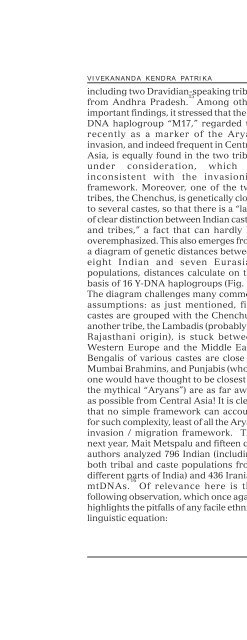Aryan Invasion Theory - Publication - Vivekananda Kendra
Aryan Invasion Theory - Publication - Vivekananda Kendra
Aryan Invasion Theory - Publication - Vivekananda Kendra
You also want an ePaper? Increase the reach of your titles
YUMPU automatically turns print PDFs into web optimized ePapers that Google loves.
VIVEKANANDA KENDRA PATRIKA<br />
including two Dravidian-speaking tribes<br />
from Andhra Pradesh. 15<br />
Among other<br />
important findings, it stressed that the Y-<br />
DNA haplogroup “M17,” regarded till<br />
recently as a marker of the <strong>Aryan</strong><br />
invasion, and indeed frequent in Central<br />
Asia, is equally found in the two tribes<br />
under consideration, which is<br />
inconsistent with the invasionist<br />
framework. Moreover, one of the two<br />
tribes, the Chenchus, is genetically close<br />
to several castes, so that there is a “lack<br />
of clear distinction between Indian castes<br />
and tribes,” a fact that can hardly be<br />
overemphasized. This also emerges from<br />
a diagram of genetic distances between<br />
eight Indian and seven Eurasian<br />
populations, distances calculate on the<br />
basis of 16 Y-DNA haplogroups (Fig. 1).<br />
The diagram challenges many common<br />
assumptions: as just mentioned, five<br />
castes are grouped with the Chenchus;<br />
another tribe, the Lambadis (probably of<br />
Rajasthani origin), is stuck between<br />
Western Europe and the Middle East;<br />
Bengalis of various castes are close to<br />
Mumbai Brahmins, and Punjabis (whom<br />
one would have thought to be closest to<br />
the mythical “<strong>Aryan</strong>s”) are as far away<br />
as possible from Central Asia! It is clear<br />
that no simple framework can account<br />
for such complexity, least of all the <strong>Aryan</strong><br />
invasion / migration framework. The<br />
next year, Mait Metspalu and fifteen coauthors<br />
analyzed 796 Indian (including<br />
both tribal and caste populations from<br />
different parts of India) and 436 Iranian<br />
mtDNAs. 16<br />
Of relevance here is the<br />
following observation, which once again<br />
highlights the pitfalls of any facile ethniclinguistic<br />
equation:<br />
47<br />
ARYAN INVASION THEORY<br />
“Language families present today in<br />
India, such as Indo-European, Dravidic<br />
and Austro-Asiatic, are all much younger<br />
than the majority of indigenous mtDNA<br />
lineages found among their present-day<br />
speakers at high frequencies. It would<br />
make it highly speculative to infer, from<br />
the extant mtDNA pools of their<br />
speakers, whether one of the listed above<br />
linguistically defined group in India<br />
should be considered more<br />
‘autochthonous’ than any other in respect<br />
of its presence in the subcontinent.”<br />
We finally jump to 2006 and end with two<br />
studies. The first was headed by Indian<br />
biologist Sanghamitra Sengupta and<br />
involved fourteen other co-authors,<br />
including L. Cavalli-Sforza, Partha P.<br />
Majumder, and P. A. Underhill. 17<br />
Based<br />
on 728 samples covering 36 Indian<br />
populations, it announced in its very title<br />
how its findings revealed a “Minor<br />
Genetic Influence of Central Asian<br />
Pastoralists,” i.e. of the mythical Indo-<br />
<strong>Aryan</strong>s, and stated its general agreement<br />
with the previous study. For instance, the<br />
authors rejected the identification of<br />
some Y-DNA genetic markers with an<br />
“Indo-European expansion,” an<br />
identification they called “convenient but<br />
incorrect ... overly simplistic.” To them,<br />
the subcontinent’s genetic landscape was<br />
formed much earlier than the dates<br />
proposed for an Indo-<strong>Aryan</strong><br />
immigration: “The influence of Central<br />
Asia on the pre-existing gene pool was<br />
minor. ... There is no evidence<br />
whatsoever to conclude that Central Asia<br />
has been necessarily the recent donor<br />
and not the receptor of the R1a lineages.”<br />
This is also highly suggestive (the R1a

















